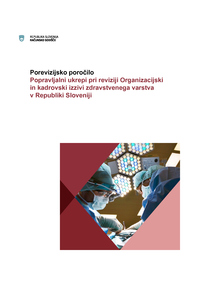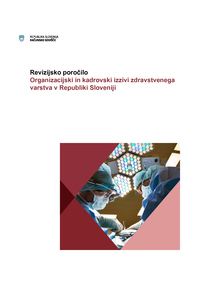The Court of Audit of the Republic of Slovenia implemented an audit of efficiency of the Ministry of Health as regards managing the field of healthcare system in the part relating to organisation and staffing coverage of healthcare activities within the public healthcare network in the Republic of Slovenia in the period from 1 January 1992 to 1 June 2016. In 1992, cardinal laws on healthcare were adopted which have not changed significantly since.
The Court of Audit assessed that in the period covered by the audit the Ministry was not efficient.
The first part of the audit report includes an analysis of 46 regularity and performance audits of operations of the Ministry already implemented by the Court of Audit in the past. Pointed out were some key recurring risks further presented in the continuation of the audit report.
The Court of Audit first examined the role of the Ministry in setting up public healthcare network which represents the basic organisational structure in the field of healthcare activities and established that the Ministry was not always consistent in exercising its powers and responsibilities. The initial healthcare plan respectively resolution, which should lay down criteria for building up public healthcare network, was adopted only in 2000 and thus not as initially planned. By the time the resolution was adopted the scope of public healthcare network was not to be modified, yet the types of healthcare services performed by public institutes were changed and concessions were granted already prior to 2000. This led to modifications of public healthcare network without any reference to appropriate legal or professional bases. In the period from 1992 to 2016, two resolutions were in force and were valid only for the period of 9 out of 24 years.
The Ministry had neither reliable, accurate and up-to-date data and records nor documentation kept allowing for overview of the public healthcare network organisation and at the same time representing a solid basis for making decisions. Such disorderly situation applies to both public healthcare institutes established by the Republic of Slovenia and concessionaires. The Court of Audit assessed that due to passive role of the Ministry, public institutes were to a greatest extent allowed to decide on which healthcare services to perform and thus also to define public healthcare network at secondary level without taking into account human resources needs and the vision of the public healthcare network development.
Despite taking some crucial steps in the right direction, the Ministry lacked complete and detailed overview of the situation in the field of issuing licences and granting concessions to private healthcare services providers. Since 2000, the Ministry tried to establish the records on granted concessions at least three times but they are still not complete and accurate. The Court of Audit expressed the opinion that the Ministry lacked an overview of the concessions granted on performing healthcare services and of consents given to municipalities for granting concessions at primary level. In 2014, the Ministry commenced a review of documentation on concessions granted and, in addition to examining the regularity of concessions granted and of consents for granting concessions at primary level, started improving records of concessions already granted.
Contrary to some municipalities that already followed the practice of granting concessions through public procurement, the Ministry carried out the first call for tenders for granting concessions at secondary level only in April 2016. It thus failed to provide competitiveness among interested private providers of healthcare services within public healthcare network. The Court of Audit expressed the opinion that the Ministry was granting concessions inconsistently, incomparably and non-transparently. It was also not evident whether the Ministry granted concessions in accordance with the objectively identified needs for the public healthcare network modification. It responded to the applications for awarding concessions without having a vision of public healthcare network development, overview of the existing organisation and needs. The Court of Audit believes that concessions granted in such a way could be considered an interference with the public healthcare network causing a risk of the network not being organised at its optimum and not following the needs of the population.
Since 2008, the Ministry is responsible for exercising control over legality of operations of the Health Insurance Institute of Slovenia and over eligible use of funds for financing health programmes and services, and thus indirectly for exercising control over the implementation of general agreement. However, the Ministry did neither exert control over the Health Insurance Institute of Slovenia nor systematic controls over the chambers exercising public powers.
The Ministry did also not make clear assessments covering the situation analysis and forecasts of future
long-term human resources needs. Nevertheless, on the basis of the Ministry's and of other stakeholders' documentation, publicly available reports and analyses the Court of Audit came to a conclusion that the Ministry lacked the overview of the healthcare staff utilisation.
The Court of Audit demanded from the Ministry to implement the required corrective measures, namely to continue with the activities the Ministry had already been carrying out (some even before the performance of the audit) to provide more efficient regulation of the audited field. It also recommended to the Ministry to re-examine its internal operations, especially interrelation and cooperation of individual organisational units, which are the key elements of disclosed inefficiencies as assessed by the Court of Audit.



